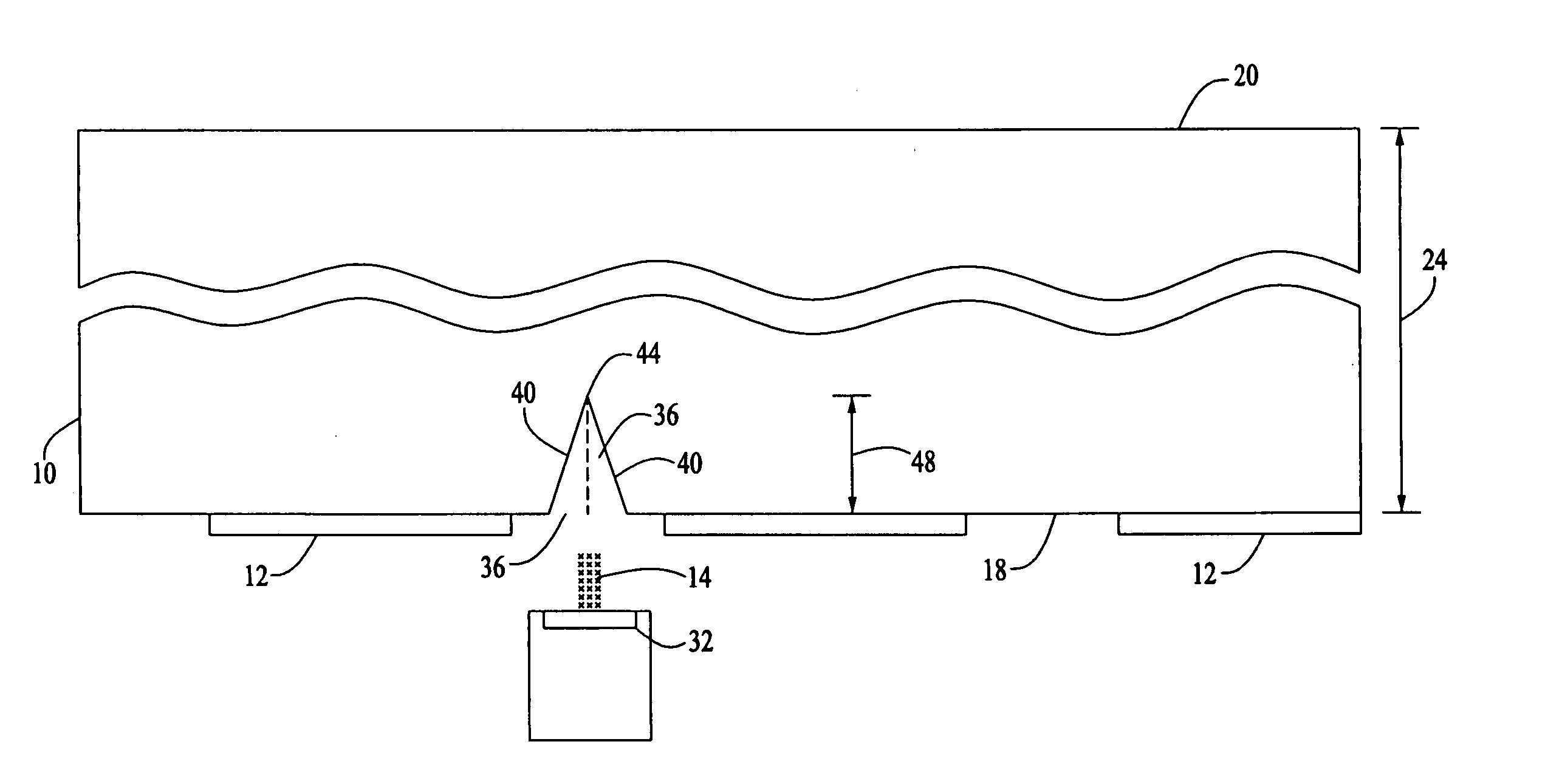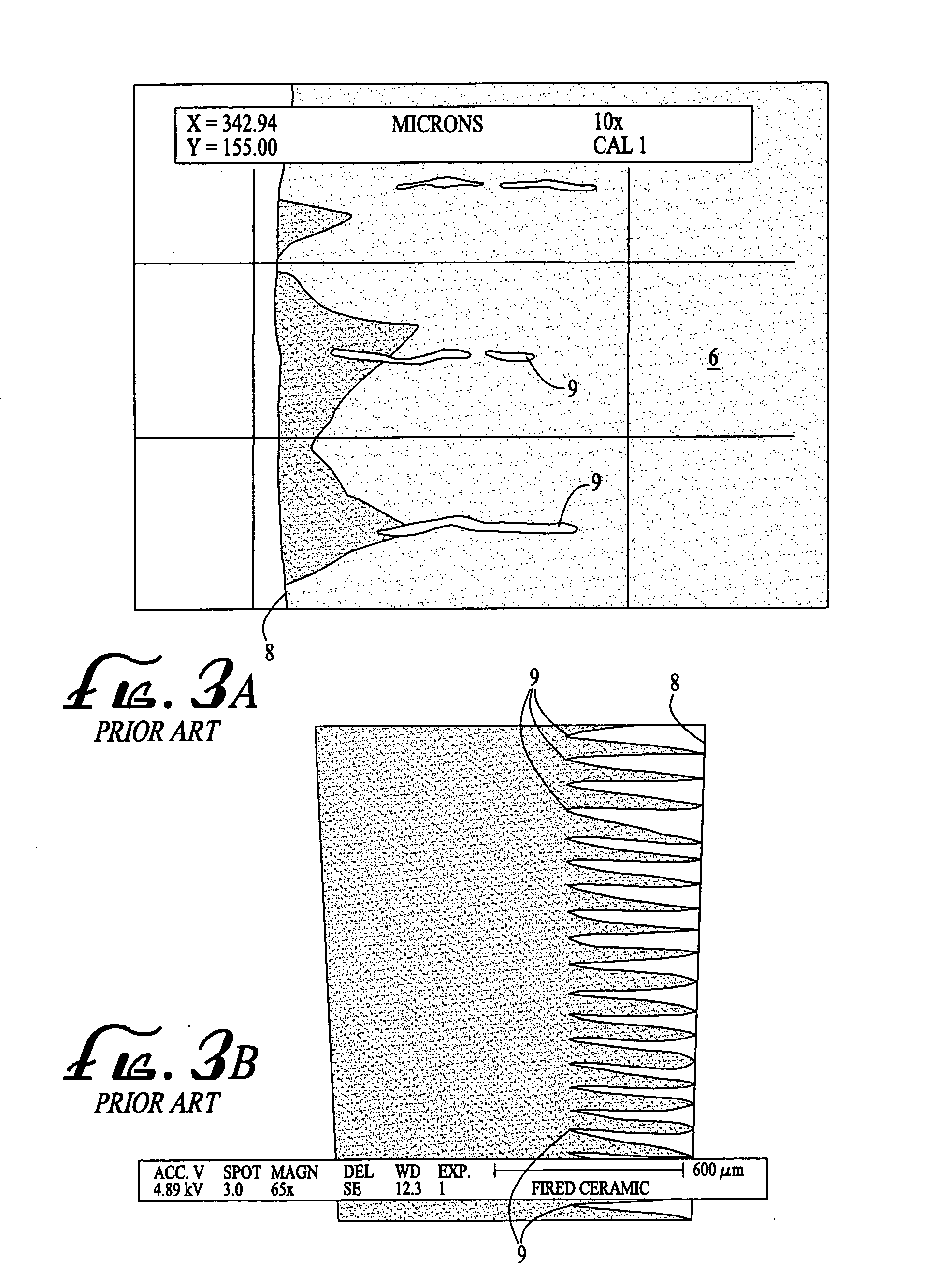Method of forming a scribe line on a passive electronic component substrate
a technology of electronic components and substrates, applied in metal working apparatus, manufacturing tools, welding/soldering/cutting articles, etc., can solve the problems of reducing the strength of ceramic substrates, structural weak components, and reducing the ability of ceramic substrates to withstand thermal or mechanical stress
- Summary
- Abstract
- Description
- Claims
- Application Information
AI Technical Summary
Benefits of technology
Problems solved by technology
Method used
Image
Examples
example 1
Lower Power, Higher Repetition Rate Micromachining
[0055] A scribe line was formed on a fired ceramic substrate material having a thickness of 0.913 mm using a Model No. V03 laser, manufactured by LightWave Electronics of Mountain View, Calif., emitting a 25 micron Gaussian beam and positioned in a Model No. 5200 laser system, manufactured by Electro Scientific Industries. The process was run at an effective rate of 0.5 mm / s (actual rate=25 mm / s / repetitions). The operational parameters used are listed in Table I.
TABLE IOperational Parameters.PRF3 kHzAvg. Power1.4 WMin. Power1.4 WMax. Power1.4 WWavelength355 nmStability*100%Energy / Pulse466.7 uJFluence95 J / cm2Speed25 mm / sBite Size8.33 micronsSpot Diameter25 micronsNo. of1 to 50Repetitions
*stability is a measure of pulse-to-pulse laser stability.
Repetitions are the number of passes the laser beam makes over a specific area.
[0056] Following formation of the scribe line, the ceramic material was broken along the line to form two sing...
example 2
Higher Power, Lower Repetition Rate Micromachining
[0057] A scribe line was formed on a fired ceramic substrate material having a thickness of 0.962 mm using a Model No. Q301 laser, manufactured by LightWave Electronics of Mountain View, Calif., emitting a 25 micron Gaussian beam and positioned in a Model No. 5200 laser system, manufactured by Electro Scientific Industries. The operational parameters used are listed in Table III.
TABLE IIIOperational ParametersPRF15 kHzAvg. Power7.27 WMin. Power7.25 WMax. Power7.29 WWavelength355 nmStability*99.3%Energy / Pulse484.7 uJFluence98.7 J / cm2
*Stability is a measure of pulse-to-pulse laser stability.
[0058] Three separate trials were performed at varying speeds and bite sizes as indicated in Tables IV, V, and VI.
TABLE IVTrial #1Speed25 mm / sBite Size1.667 micronsSpot Diameter25 micronsNo. of Repetitions1 to 2Effective Speed12.5 mm / s
[0059]
TABLE VTrial #2Speed 50 mm / sBite Size3.33 micronsSpot Diameter 25 micronsNo. of Repetitions 2Effectiv...
example 3
Higher Power, Lower Repetition Rate Micromachining
[0064] A scribe line was formed on a fired ceramic substrate material having a thickness of approximately 100 microns using a Model No. Q302 laser, manufactured by LightWave Electronics of Mountain View, Calif., emitting a 25 micron Gaussian beam and positioned in a Model No. 5200 laser system, manufactured by Electro Scientific Industries. The operational parameters used are listed in Table VIII.
TABLE VIIIOperational ParametersEffectiveWave-Avg.RepetitionEnergy / PulseMax.SpotlengthPowerRatePulseNo. ofWidthPowerDiameterFluence(nm)(W)(kHz)(μJ)Repetitions(ns)(kw)(μm)(J / cm2)3553.950781253.12301.10
[0065] The laser beam was moved at a programmed speed of 100 mm / s and an effective speed of 50 mm / s. The total depth of the scribe line was approximately 28 microns. Because the bite size was approximately 2 microns, there was significant overlap in each of the two repetitions. Following formation of the scribe line, the ceramic material was ...
PUM
| Property | Measurement | Unit |
|---|---|---|
| energy | aaaaa | aaaaa |
| energy | aaaaa | aaaaa |
| power | aaaaa | aaaaa |
Abstract
Description
Claims
Application Information
 Login to View More
Login to View More - R&D
- Intellectual Property
- Life Sciences
- Materials
- Tech Scout
- Unparalleled Data Quality
- Higher Quality Content
- 60% Fewer Hallucinations
Browse by: Latest US Patents, China's latest patents, Technical Efficacy Thesaurus, Application Domain, Technology Topic, Popular Technical Reports.
© 2025 PatSnap. All rights reserved.Legal|Privacy policy|Modern Slavery Act Transparency Statement|Sitemap|About US| Contact US: help@patsnap.com



